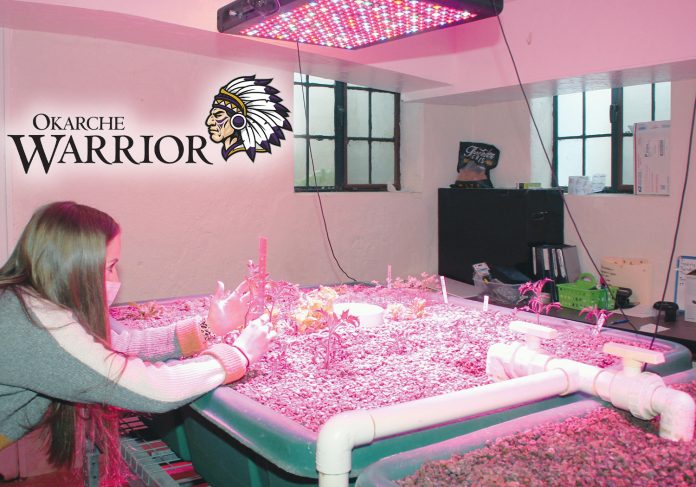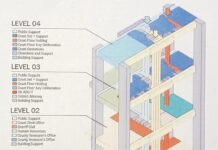
By Carol Mowdy Bond
Contributing Writer
Founded in 2015, BlueSTEM AgriLearning Center, located at 3232 N. Jesse Reno Street on the historic Fort Reno grounds near El Reno, functions with a mission to strengthen ties between the United States Department of Agriculture’s Agricultural Research Service Grazinglands Research Laboratory and local school districts, to enhance STEM educational opportunities for students. STEM is a curriculum based on the idea of educating students in the four specific disciplines of science, technology, engineering, and math. And by 2017, Oklahoma Governor Mary Fallin honored BlueSTEM as an official Oklahoma STEM Community, which is a coveted and hard-won title that lends credibility to the program and helps in obtaining grants.
The center’s name derives from bluestem, a native prairie grass. And the USDA’s Agricultural Research Service Grazinglands Research Laboratory, at Fort Reno, is one of the few tall grass prairie preserves in the state. The USDA owns Fort Reno, and BlueSTEM is located in the historic fort’s commanding officer’s quarters, built in 1876.
Although a collaborative effort with sponsors including many individuals, businesses, industries, schools, and government, the USDA’s Agricultural Research Center Grazingland Research Laboratory is the BlueSTEM Agrilearning Center’s primary partner. The center is a location where STEM and agriculture meet, preparing students for their futures. As a 501(c)(3) nonprofit that is fully grant-and-donation funded, from its inception BlueSTEM began pairing high school students, one on one, with actual USDA scientists, to complete projects that involved students doing primary research.
BlueSTEM functions through various means including community outreach, education internships, outdoor education days, and teacher professional development. And the center even offers family science night events. As well, Agricultural Research Service mentors are still involved. Besides the educational aspect, the center’s goal is to improve communication about the importance of agriculture, agricultural research, and the findings of the Grazinglands Research Laboratory to the public
During outdoor educational days, participants often have station rotations of 10 to 25 minutes (depending on the student ages) where small groups learn about a topic and often make-n-take, then move to the next station and repeat until all students have experienced all stations. The educational station topic list is extensive, and offers everything from butter making, Dutch oven cooking, and history in a box, to forensic science and tree rings, and everything in between.
In a normal, non-COVID-19 school year, from August through May, several thousand students would be involved in BlueSTEM activities or programs. With the pandemic still upon us, there are just a few students who at times are in the BlueSTEM building, but there are also many who are participating virtually.
This year, BlueSTEM is working with students, elementary through high school, from the El Reno, Yukon, and Calumet school districts. University students who are interested would be welcome to contact the center, and look into what the center offers that might be of value to them.
Hoping to keep the program growing, and expand into other school districts, the educational director, Ann Marshall said, “We want to let people know what we have here. And it’s all free. We don’t charge tuition, except on our educational days. Then we charge $2 per student just to cover our costs. We don’t make any money. I want people to come and see us and know all about our program. Most people come out and are stunned when they see what we do here. We would like to bring in students from other schools around our area.”

With no budget for advertising, because the center is grant-and-donation funded, BlueSTEM primarily releases information, about what the center offers, through social media.
Dr. Kristy Ehlers serves in several roles. As an employee of the El Reno public schools, she is the director of school partnerships. But she is also the administrative director for BlueSTEM. Ehlers said, “We are only in our 6th year. So we expand as necessary or per request, for example at the request of a teacher. From August to May we usually have about 20 high school students who teach younger students. We offer a hands-on learning environment. High school students have to be responsible and self driven, and commit to four to eight hours weekly. Our center includes a 5,000 square feet garden in the shape of Oklahoma.”
Ehlers said, “We have projects on everything from bees and butterflies to plant genetics, climate, animal nutrition, hydrology, weather, and aquaponics involving fish and plants.”
Some of the past individual student projects included topics such as the weather’s impact on rural and urban landscapes, rumen digestibility, and impact of flooding on vegetation. And group projects are diverse, and in the past have even included butchering a hog and making sausage, and cutting up a deer to make deer jerky. As well, bees are kept on the property, and honey is produced.
Ehlers said, “We’re always looking for community partners. Partnerships could involve anything, even something as simple as providing us with bottled water.”
One of BlueSTEM’s partners is the Canadian County Master Gardeners, through the
Oklahoma State University Extension. The group has served in an advisory capacity, helping with both knowledge and manpower.
A current, on-site project in the works is an aquaponics system with Molly Carson as the lead student. Although other students have worked on the project with her, Molly is the intern, and she built the project from the ground up during the summer. Ann Marshall obtained a grant to put the system into place. A high school junior, Carson said, “We have gold fish in the bottom tank, and plants growing on top. The gold fish excrement is fertilizing the plants. I come every day to feed the fish and keep up with the data.”
Another project centers around how to feed a growing population with climate change. The high school students, Liberty Carson and Hannah Skadds, run the “Farm Bot Express” project with their cell phones. A robot plants and waters, check nutrients in the soil, and gives every plant exactly what it needs. The project is linked to a company involved with sustainable farming.
To connect with BlueSTEM, call (405) 208-2468, or email info@bluestemagrilearning.org, or on the web at http://bluestemagrilearning.org. On Facebook, go to BlueSTEM Agrilearning, or on Twitter @BlueSTEMAg, or Instagram at bluestem_agrilearning_center.





